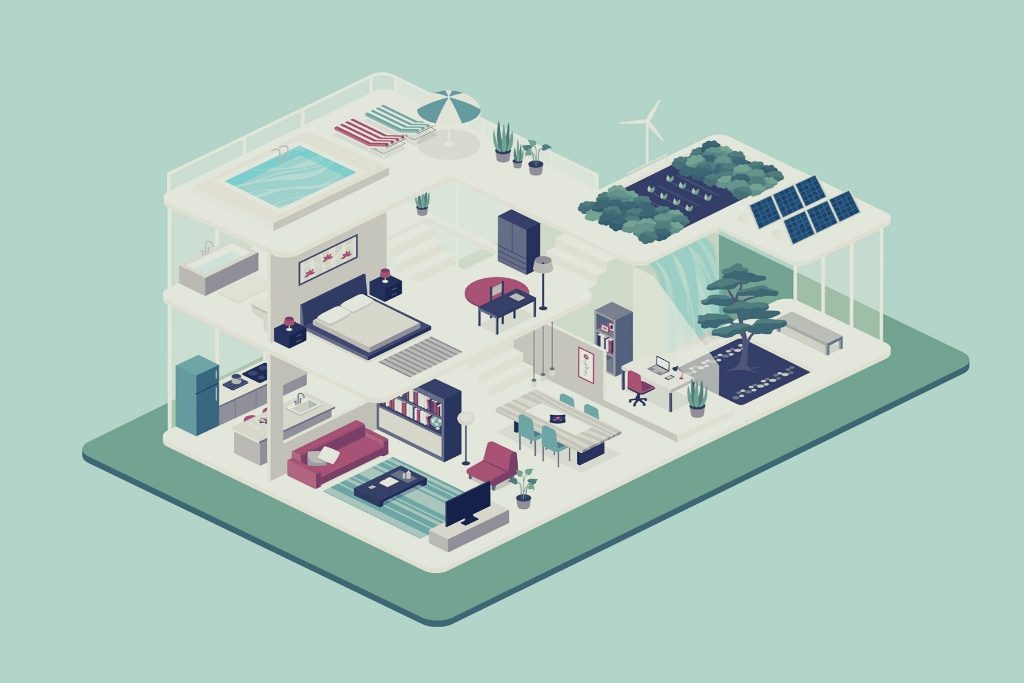Buildings are to blame, in part, for today’s staggering rates of global warming. As they constitute a whopping 39 percent of the worldwide carbon emissions, it’s not possible to stop the catastrophic temperature rise without making buildings greener. Luckily, the proliferation of net-zero energy construction is doing exactly that, turning this environmental liability into an opportunity.
Construction is growing so fast that over the next 40 years, the world will add 230 billion square meters of new construction, the equivalent of adding another Paris every week. This rapid development makes implementing and scaling net-zero construction more crucial than ever.
Hence, it’s no shock that the global net-zero energy building industry earned $896.6 million in revenue in 2018 alone. These figures might hit $2.1 billion by 2024 thanks to growing demands to reduce greenhouse gas emissions and increasing requirements for net-zero energy construction of new buildings.
At 98.4 percent, the commercial sector makes up the bulk of the net-zero energy building market, though the residential sector is set to grow.
What’s a Net-Zero Energy Building?
Well, it’s a building with net-zero energy consumption, which means that the energy it consumes each year is balanced out by the renewable energy it creates. Building emissions fall into two categories:
- building operations from the daily energy use of things like heating, cooling, and lighting (which combined constitutes 28 percent of global carbon emissions) and
- the construction process and materials used. At 11 percent of global emissions, the second includes things like transporting construction materials and operating construction machinery.
These energy-efficient buildings are often designed using recycled materials and then made to use as little energy as possible once operational. This can be done with state of the art construction technologies like spray-foam insulation, high-efficiency heat pumps, and triple glazed windows. Once active, net-zero energy buildings use technology such as solar panels to generate green energy to offset whatever energy the building still uses.
From an Experiment to a Norm

One of the first commercial net-zero buildings in the world was the Adam Joseph Lewis Center for Environmental Studies at Oberlin College in the U.S., completed in 2000. It was built to both minimize the energy it used and to produce electricity onsite through solar panels. At the time, it was mostly experimental and intended as a teaching tool. By March 2012, however, the number of commercial buildings in the U.S. that met net-zero standards had grown to at least 21.
Today, governments around the world are unrolling policies to incentivize net-zero or nearly zero-energy buildings in construction. The EU’s Energy Performance of Buildings Directive mandates, for example, that all new buildings must be nearly zero-energy buildings (NZEB) from 31 December 2020. A 2018 survey showed that half of the organizations surveyed across 20 countries are planning at least one net-zero energy building over the next decade, and another 59 percent plan to increase their investment in energy efficiency. There are good reasons to do so: every dollar spent on energy efficiency returns $3 over time.
The Global Spread of Net-Zero Energy Construction
Net-zero energy construction is growing in scope and ambition. In the United Kingdom, the Beddington Zero Energy Development, or BedZED, is the country’s largest eco-village. Hundreds of meters of solar panels generate energy and innovations in sustainable building materials, low-energy appliances, and roof gardens to help keep energy use down. In Trondheim, Norway, the Powerhouse Brattorkaia is an eight-story office building that is energy-positive using strategies like smart heating and a seawater refrigeration system. Indonesia’s state-owned energy company Pertamina is constructing what it hopes will be the first net-zero energy skyscraper, The Pertamina Energy Tower, set to be completed in 2020.
What’s Next?
A variety of net-zero building trends are shaping and refining the industry. An exciting set of tools are emerging to help calculate the carbon footprint of a building when it is being designed, which can be integrated with Building Information Modeling, or BIM, to quantify a building’s entire carbon footprint from conception to demolition. Eco-friendly building materials are innovating rapidly, including spray foam insulations, so that no heat escapes, smart doors which optimize the opening and closing to save energy, and water conservation measures such as rainwater catchment systems and low-flow toilets. These innovations prove it is only the beginning of this industry on the rise.






